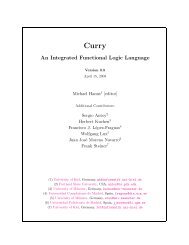Conformal Geometric Algebra in Stochastic Optimization Problems ...
Conformal Geometric Algebra in Stochastic Optimization Problems ...
Conformal Geometric Algebra in Stochastic Optimization Problems ...
Create successful ePaper yourself
Turn your PDF publications into a flip-book with our unique Google optimized e-Paper software.
6.1. GEOMETRIC ALGEBRA AND ITS TENSOR NOTATION 181<br />
By means of Φf it becomes possible to assign vectors to algebra elements. Hence<br />
regard<strong>in</strong>g the preced<strong>in</strong>g text it is Φf(A) = a, Φf(B) = b and Φf(C) = c.<br />
It is quite scar<strong>in</strong>g that every CGA tensor that corresponds to a b<strong>in</strong>ary operation<br />
(a unary operation, by contrast, is e.g. the reverse) consists of 2 53 = 32768 coefficients.<br />
This would cause some CGA expressions to be <strong>in</strong>operable. So, <strong>in</strong> practice,<br />
the complexity of calculations can be reduced considerably by us<strong>in</strong>g masked multivectors.<br />
A l<strong>in</strong>e L, for example, can <strong>in</strong>ternally be stored by six coefficients with<br />
associated mask<br />
where<br />
L = 0.45e12 + 0.89e23 + 0.47e2e<br />
�<br />
↓<br />
�<br />
l<strong>in</strong>e mask, [0.45 0.89 0 0 0.47 0] ,<br />
l<strong>in</strong>e mask = [ 0<br />
0 0 0 0 0<br />
1 2 3 4 5 6 4 5 6 0<br />
0 0 0 0 0 0 0 0 0 0<br />
0 0 0 0 0<br />
0 ]<br />
Aside: The l<strong>in</strong>e mask conta<strong>in</strong>s double <strong>in</strong>dices because basis blades like 0.47e2e<br />
correspond to the two components 0.47e2e+ and 0.47e2e−, respectively, due to<br />
e = e+ + e− (<strong>in</strong>ternally the e+e−-basis is used), see page 85.<br />
Accord<strong>in</strong>gly, a map Φ can be def<strong>in</strong>ed that replaces Φf - the full mapp<strong>in</strong>g. The<br />
new Φ only maps the m<strong>in</strong>imum number of coefficients necessary presum<strong>in</strong>g the<br />
correspond<strong>in</strong>g mask is known<br />
Φ : �p,q −→ � k , k ≤ n<br />
X ↦−→ x<br />
To understand this consider an OPNS circle C ∗ from which a l<strong>in</strong>e LC = −e · C ∗ is<br />
to be calculated accord<strong>in</strong>g to equation (3.49). As it is known beforehand that C ∗<br />
is a 3-blade, it follows<br />
Φ(C ∗ ) ↦−→ c ∈ � 10<br />
Φ(e) ↦−→ e ∈ � 1<br />
Φ(L) ↦−→ l ∈ � 6 .<br />
Note that generally the outer product of two vectors, for <strong>in</strong>stance, will not produce<br />
3-vector components such that these can be disregarded. Analogously, with the<br />
help of Φ the dimensions of the product tensor for the <strong>in</strong>ner product −e · C ∗ , <strong>in</strong><br />
the follow<strong>in</strong>g denoted by Q, can be restricted to only those components of the<br />
multivectors that are actually needed. Then Q can be determ<strong>in</strong>ed such that<br />
l k = −e i Q k ij c j<br />
with Q ∈ � 6×1×10 .<br />
So exploit<strong>in</strong>g the <strong>in</strong>ternal structure of CGA elements, the operation can effectively<br />
be carried out by means of a 6-by-10 matrix rather than by a 3-valence tensor with<br />
32768 elements.
















